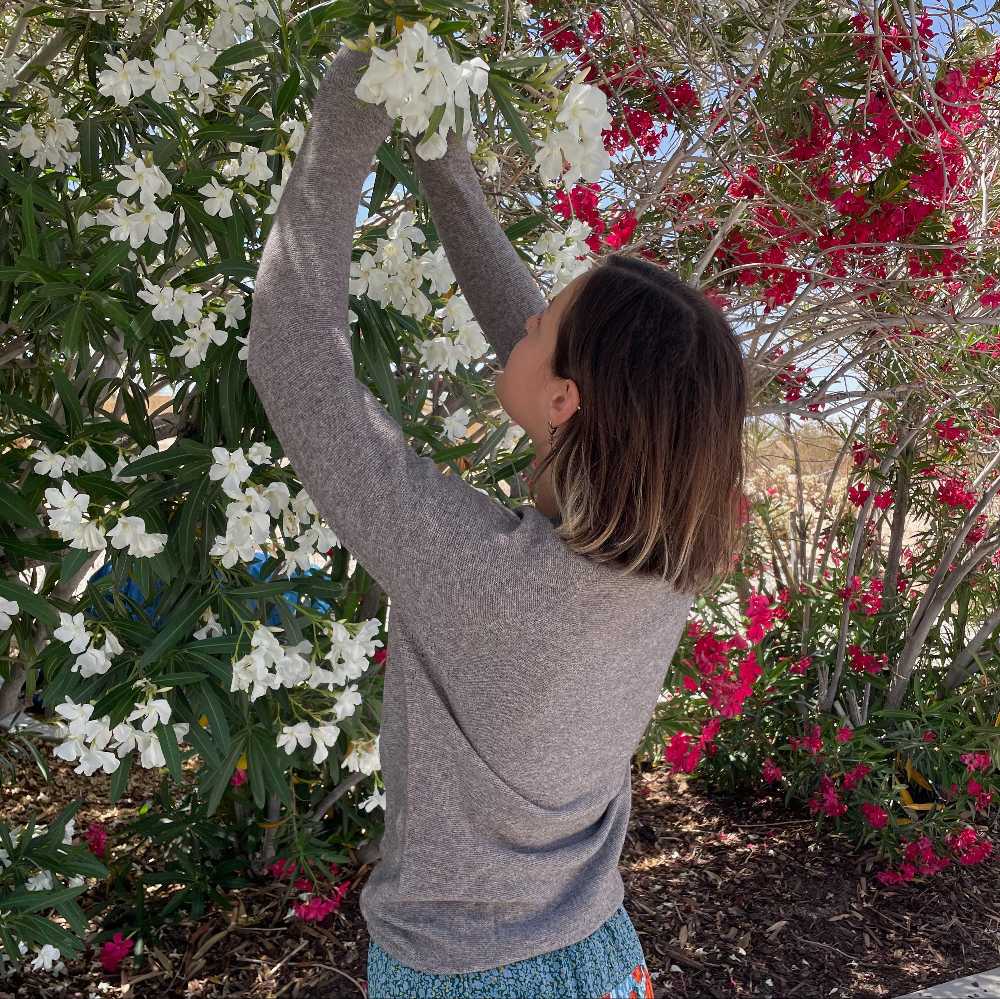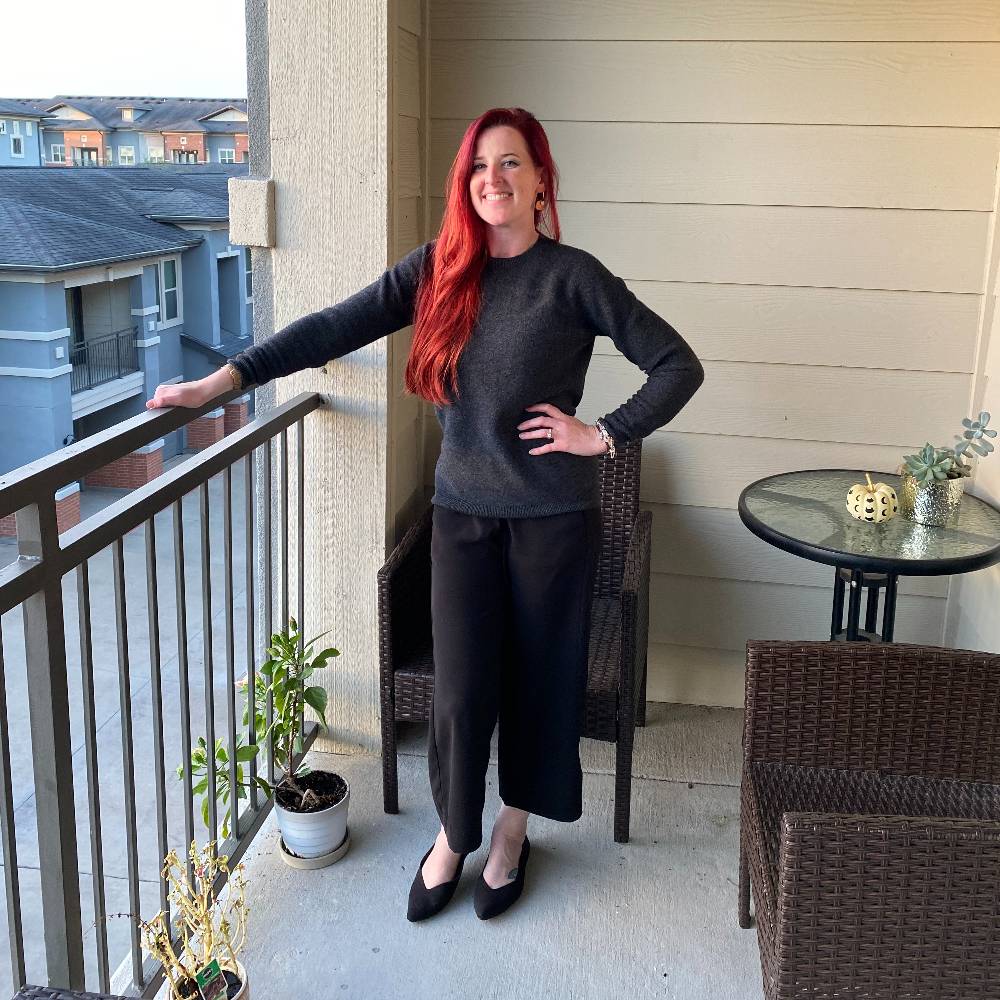Khullu And Eco-Friendly Clothing
Creating a sense of style that’s aligned with the natural world.
May 26, 2022
By
Lia Klinchik
Growing up, it wasn’t often that my mom took me shopping at a department store.
I spent what I feel like was a lot of my childhood wandering around the same consignment store in Central Jersey.
Doo-woopy, finger-snapping, 50s pop music rang in my ears as I got lost in the dusty barbies and towering coat racks. I almost never left the store without a new-to-me article of clothing.
As it goes, in my teenage years, I found myself digging through my mom’s closet. Flowy, bohemian pieces of cotton and linen kindly cloaked my body.
Unlike the cheap crop tops that suffocated my chest, these allowed me to breathe. I felt more me in her oversized, linen shirts and wide-leg pants, reminiscent of a fairy.
Though it was just her way to upcycle what she found at thrift stores, sifting through junk to find only high-quality fabrics, I credit her for shifting my perception of what to buy and my personal style.
It wasn’t until recent years that I realized the huge environmental impact our clothing consumption habits have, which has made me even more inclined to stay away from unconcerned, fast fashion companies.
I changed my wardrobe over time to fit mostly natural and sustainable fabrics because they feel better on my body.
I’ve fallen in love with genuine fibers, like wool and linen. I appreciate their simplicity and timelessness.
And it just so happens that neutral garments are most suitable for a lifestyle that’s abundant with travel and puttering through the woods.

Sustainable Materials: Why Own Them?
Some of the most common clothing fabrics are polyester, nylon, and acrylic. So what are these fabrics made out of, and why are they so affordable?
- Polyester: Made from PET plastic. PET is Polyethylene Terephthalate, a synthetic polymer. For reference, PET plastics can also be found in packaging.
- Nylon: Processed from crude oil and goes through a long drawn-out process to become your stockings.
- Acrylic: Synthetic fiber developed from coal and petroleum. A chemical process turns it into plastic fibers.
The reason these fabrics are cheap is because their raw material sources are inexpensive and manufactured quickly.
Sure, prices are lower and this type of clothing is accessible, but what’s the catch?
All three of these fabrics require chemical processing at the expense of pollution on our planet.
Though natural fabrics may use more resources like water, synthetic fibers emit more greenhouse gases per kilogram, contributing to our current climate crisis.
Synthetic fibers depend on fossil fuels for production, leading to air pollution. At the very source, natural resources, like crude oil, require drilling for extraction.
These things are taken without a plan for reciprocation back to the Earth.
Did you know that clothing is one of the top contributors to pollution?
Microplastics In Humans
Do not even get me started on microplastics. These are the result of plastics breaking down over long periods of time. They are found in all sorts of household and beauty products. They are also leaching from synthetic clothing.
Microplastics are everywhere, even in our drinking water, which is a scary motivator to cut down your use of plastic and plastic-containing products.
Microplastic fibers have been popping up across the board due to trashed clothing - and a lot of it.
The World Resources Institute published an article discussing the apparel industry’s environmental impact and dropped an astonishing fact.
Every time you wash a synthetic article of clothing, it loses up to 2,000 microplastic fibers, which eventually can end up virtually anywhere on the planet.
The problem with this is that these fibers cannot break down completely. They end up in our bellies and those of wildlife.
A study on microfiber pollution displayed that textile fibers were found in human lungs way back in 1998!
Is Recycled Polyester Fabric Eco-Friendly?
But what about recycled synthetic fabrics then? An article in Vogue Business had a good point about the use of recycled synthetics.
Companies claiming that they’re helping the environment by using these recycled synthetics are contributing by making it okay for the production of synthetic fabrics to stick around.
It isn’t a solution...

Eco-Friendly Wardrobe: What's In One?
What are some fabrics you should look for when creating your eco-friendly wardrobe?
My favorite natural fabrics are SeaCell, cotton, linen, and wool. Hemp is another environmentally-friendly choice too.
Linen, cotton, and hemp are made from plant material. While linen is made from the flax plant, cotton and hemp are self-explanatory.
Linen and hemp are the most sustainable plant-based options because they don’t require as much water to grow as cotton does.
Wool can be made from various animals: sheep, llama, alpacas, etc.
Khullu comes from yaks. What’s so special about yak wool is that it has been worn for centuries and still is by nomadic tribes.
We look to natural fibers to align ourselves with the natural world because our ancestors didn’t have the means to create all these fancy synthetic materials.
What they had were the plants and their animals to help protect and shield their bodies. When things got old or ripped, they were repaired or reused.
It wasn’t trendy to be sustainable; it was just their way of life. There is something to be learned in that.
With natural fibers, you don’t have to worry about things like microplastic pollution, but it’s important to acknowledge that there are issues with companies manufacturing natural fabrics as well.
There can be problems with: pollution due to improper dumping of chemicals and pollution in waterways, use of pesticides, and slave labor.
That is why I’d like to emphasize that you should always buy from trustworthy companies and choose the organic, fair-trade fabric option when possible.
Natural fibers have many desirable qualities: warmth, moisture-wicking, durability, versatility, thermoregulation, and antimicrobial properties.
These fibers are high quality, durable, and last a long time. They allow your skin to breathe. One of the issues with synthetic fabrics is that they prevent your skin from breathing, which can result in acne or skin irritation.
Skin that stays wet in a tight area can cause topical fungal infections. If there is airflow, it allows sweat to evaporate instead of hanging around on the skin.
And natural just plain looks good! Earthy colors go with everything. I’m beaming with excitement over the new undyed sweater Oliver Charles has put out.
I truly value the thought and care that goes into the production of their sweaters. I find peace of mind in the sourcing of the wool and the truth in how excellently khullu performs in my daily life, whether that be road-tripping on the weekends or snuggling in bed during the week.
Khullu is self-cleaning and can be worn repeatedly. Fewer washes mean less water usage and less environmental impact.

5 Ways To Make Your Wardrobe Eco-Friendly
- Buy from companies with morals: You can do this by seeking transparency from the companies you buy from. If they’re being unclear about where they source and how they do business, then that’s an indicator that something’s not right.
Trustworthy companies are ones that are cruelty-free, have a low carbon footprint, and treat their workers well. Even companies that sell natural fabrics have had an overwhelming issue with slave labor and sourcing ethically. - Keep a lookout for greenwashing: Greenwashing is a term used to describe the marketing a company does to make the consumer believe their product is eco-friendly or natural when in reality, it’s not.
Walmart was called out recently in April 2022 for claiming their rayon products were made using “eco-friendly processes” when in actuality, rayon requires the use of toxic chemicals to produce.
This leaves us with a good example of why we should be concerned about the fabrics we wear and not just our beauty products. Doing your research and checking your facts is the best way to avoid false claims about popular eco-friendly products. - Shop clothes that last decades: This is part of the reason you want to choose fabrics like cotton, linen, and wool. They are made of hardier materials that don’t break down easily.
Spending $5 on a cheap shirt that’s going to fall apart and you’ll have to replace will cost you more in the long run than spending $20+ on a high-quality shirt (or sweater). Invest in versatile pieces you love. - Shop at small businesses: Minimize your impact on the environment by buying from small businesses helps improve the local economy and gives you the opportunity to ask those important questions like where they source form. It’s another way you can help lift other people up and support them.
- Repair what you already own/love: my very old, favorite pair of jean shorts are finally falling apart. There are holes and rips all over the place.
I tried sewing them, but I’m not great at it. No fear though, for those of you who can’t hand sew like me, there are sticky patches!
I refuse to get rid of them, so I repaired them that way. You can do something like this with your own old clothes and get crafty to dress it up.
Or you can go all the way and upcycle it into something completely new! And if you own or are thinking of getting one of the new undyed sweaters, I was scrolling through the Oliver Charles website and I noticed the lifetime guarantee on their sweaters.
If your sweater has knicks or holes, they will repair it for you. You don’t even have to do it yourself.

Eco-Friendly Wardrobes Bring Us To Our Roots
An eco-friendly wardrobe brings us back to our roots. This is part of helping to reduce the impact we humans have on the planet. Searching for clothing that’s well-made is so easy to do.
And also, doesn’t it just suck when you buy a cheap shirt, wash it, and it’s all pilly already?
Let’s start creating a wardrobe we can feel good in and know that we are doing good.
What we seek with an eco-conscious wardrobe is to protect the world around us.
This includes our fellow humans, plants, and the animals involved in the entire process of making textiles.
Lia Klinchik is a freelance blogger, content creator, and editor, who studies wellness and nutrition. She's passionate about sustainability, travel, and making the world a better place. Through her writing, she hopes to convey meaningful messages that change people's minds.
If you believe that every good wardrobe starts with owning less and owning better, consider buying yourself an OLIVER CHARLES sweater.
Shop NowMinimalist Wardrobe: Level Up With Fewer Sustainable Pieces
Simplify your wardrobe with these 3 easy and empowering steps.
Read moreBuilding a Versatile Wardrobe: The Everyday Sweater Capsule
How can I reduce my closet to high-quality staples that create 6 easy everyday outfits?
Read more5 Ways Outfit Repeating Improves Your Life
Ditch fast fashion for a more sustainable wardrobe (and a happier life).
Read moreYour WFH Fashion Essential: The Workleisure Sweater
How this sustainable sweater fits my work from home lifestyle.
Read more



